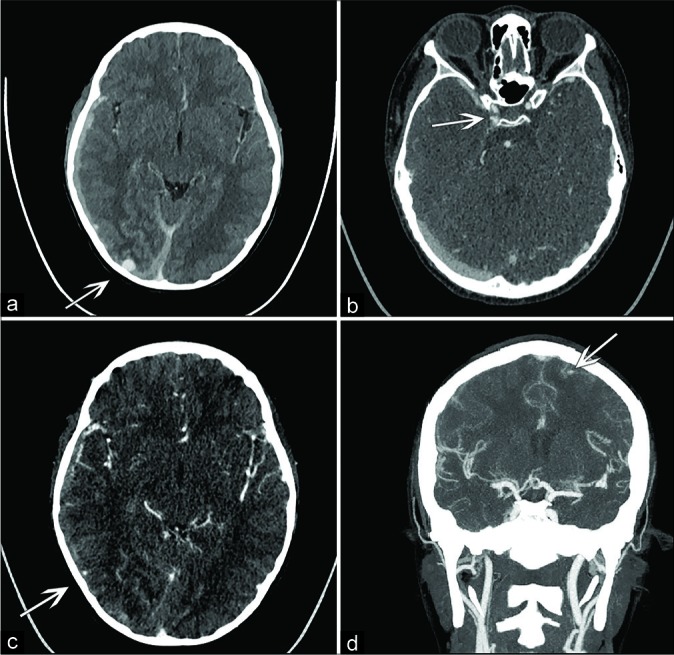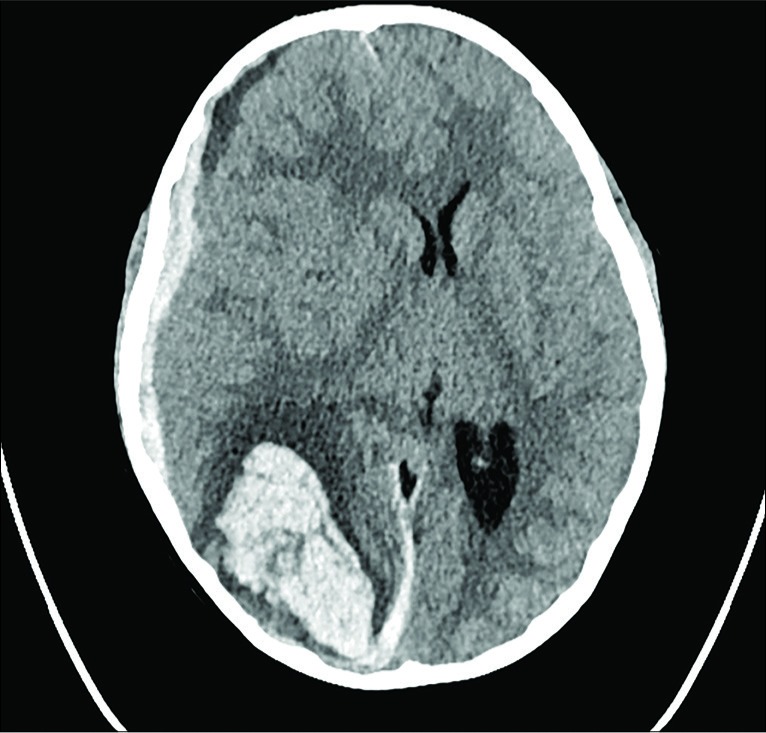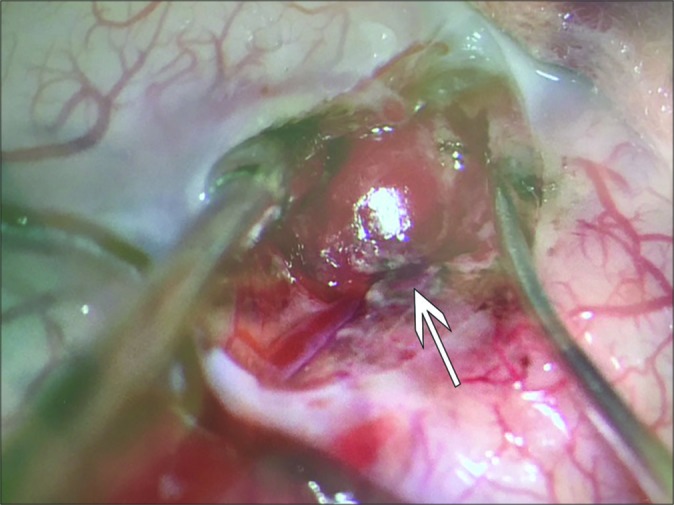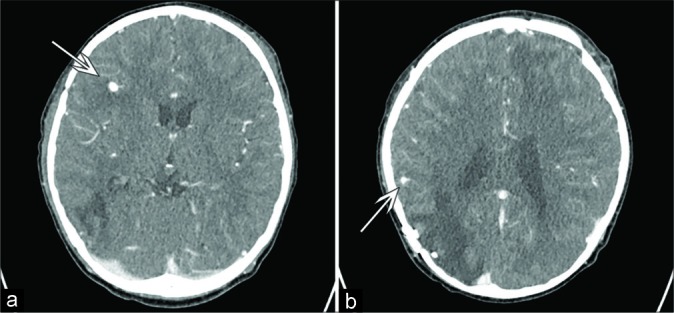Abstract
Background:
Mycotic aneurysms are a rare in the pediatric population. The natural history of these lesions and their appropriate management strategies is controversial.
Case Description:
A 13-year-old male presented with the sudden onset of a headache, vomiting, and fever. Inflammatory markers were elevated, and the blood culture was positive for Streptococcus viridans. When the computed tomography angiography (CTA) showed a ruptured mycotic aneurysm accompanied by multiple small unruptured aneurysms, he was started on antibiotics and underwent an urgent craniotomy. Despite negative blood cultures, the follow-up CTA showed further enlargement of the previously diagnosed aneurysms and a new right frontal aneurysm. The second and third craniotomies were, respectively, performed to resect the additional aneurysms. Pathologically, both aneurysmal walls were markedly inflamed and attenuated, suggesting the imminent risk of aneurysmal rupture. Following the total of three craniotomies, the patient had an uneventful postoperative course. Within 2 weeks, he regained baseline neurological function.
Conclusion:
Mycotic aneurysms in children may follow a very malignant course. Aneurysms may grow, new ones may form, and repeated CTAs are required to direct further follow-up treatment.
Keywords: De novo aneurysm, Infectious aneurysm, Pseudoaneurysms

BACKGROUND
Brain mycotic aneurysms were first described in 1885 by William Osler.[6] They are rare in the pediatric age group and constitute only 15% of all pediatric intracranial aneurysms.[5] The most common risk factor for these lesions is infective endocarditis that is most commonly attributed to, in descending order, Streptococcus viridans, Staphylococcus aureus, and fungal infections (e.g., Aspergillus).[4]
Patients usually present after an infarct or a hemorrhage. Common symptoms include fever, sepsis, headache, vomiting, deterioration of cardiac function, altered level of consciousness (e.g., due to mass effect from in hemorrhages), and neurological deficit attributed to hemorrhages/infarct.[8]
A high index of suspicion is required to establish the diagnosis of intracranial mycotic aneurysms in children. They most typically involve the distal circulation followed by the anterior cerebral artery distribution. The best test to diagnose a mycotic aneurysm is to perform a digital subtraction angiogram followed by computed tomography angiography (CTA). Other diagnostic studies that help confirm the diagnosis include positive blood culture, vegetations on an echocardiogram, and increased inflammatory markers (e.g., elevated white blood cell (WBC) count, higher C-reactive protein (CRP), and elevated erythrocyte sedimentation rate).[7]
Here, we present a 13-year-old male who developed multiple mycotic intracranial aneurysms requiring three successive craniotomies.
CASE PRESENTATION
A 13-year-old male, with a history of autism, mild developmental delay, and remote cardiac surgery, presented with the sudden onset of severe headaches and vomiting. He was febrile, but remained hemodynamically stable (e.g., normal Glasgow Coma Score) without a neurological deficit.
WBC and CRP levels were elevated, and the blood cultures were positive for S. viridans. The echocardiogram was normal; there were no vegetations. The brain computed tomography (CT) and CTA (angiogram) showed a right subdural hematoma and a focal right subarachnoid hemorrhage with a large mycotic aneurysm in the right occipital lobe without midline shift. There were also small mycotic aneurysms in the left frontal lobe, right parietal temporal junction, and right supraclinoid internal carotid artery (ICA) distributions [Figure 1].
Figure 1:

(a) The right-sided subdural hematoma with large mycotic aneurysm at the periphery of the right occipital lobe, (b) the right cavernous ICA aneurysm, (c) the right parietal temporal junction aneurysm (d) Small aneurysm of the left frontal lobe.
He was started empirically on intravenous (IV) ceftriaxone and vancomycin; this was later revised to ceftriaxone and gentamycin. The next morning, while awaiting right occipital aneurysm surgery, he woke up with a sudden recurrent headache. The right pupil became dilated and fixed; immediately, intubation with hyperventilation and hyperosmolar therapy was instituted. The brain CT showed a large right occipital, parietal, and posterior temporal lobe hemorrhage with uncal herniation [Figure 2]. He underwent an emergent right craniotomy for the evacuation of the subdural/intraparenchymal hematoma and resection of the aneurysm that had rebled.
Figure 2:

Acute right occipital lobe hemorrhage and subdural hematoma with significant midline shift and uncal herniation.
After 48 h, the repeat CT/CTA showed no new hemorrhage or aneurysm formation; the largest aneurysm in the right occipital lobe was no longer evident, and there was no evidence of significant brain edema or midline shift. He was extubated on postoperative day 3 and recovered to baseline neurological function.
Two weeks later, however, the follow-up CTA demonstrated enlargement of the left frontal aneurysms and a new right frontal aneurysm [Figure 3]. Blood cultures were negative, and the repeat echocardiograms were normal. He electively underwent a left frontal craniotomy for resection of the aneurysm [Figure 4]. Pathologically, the aneurysmal wall was markedly inflamed and attenuated, indicating the heightened potential for imminent rupture.
Figure 3:

(a) Resolution of intraparenchymal and subdural hematoma and increase in the right parietal temporal junction aneurysm 3.5 mm from 2 mm. (b) New right frontal lobe aneurysm. (c) The left frontal lobe aneurysm significantly enlarged 5 mm from 2 mm.
Figure 4:

Microscopic picture of trans-sulcus left frontal aneurysm resection.
One week later, the follow-up CTA demonstrated an increase in the size of the right deep frontal aneurysm (e.g., 2–4 mm), which was partly thrombosed, plus a small area of surrounding edema. The CTA one week after that confirmed further growth of the right frontal aneurysm to 6 mm, but no changes in the 4 mm aneurysm in the right parietal temporal junction or in the 2 mm focal bulge/nipple on the lateral wall of right supraclinoid ICA [Figure 5]. A formal angiogram showed both middle cerebral artery (MCA) aneurysms had a reasonable morphology for clipping. Therefore, the patient underwent a third craniotomy for trapping and excising both MCA aneurysms. The patient did very well after all surgeries and had no focal residual neurological deficits. Two months later, the CTA confirmed no further growth of the 2 mm focal bulge on the right supraclinoid carotid artery.
Figure 5:

(a) Further growth of the right frontal aneurysm to 6 mm. (b) No changes in a 4 mm aneurysm in the right parietal temporal junction.
DISCUSSION
The natural history of mycotic aneurysms varies. Corr et al. reported that in 33% of cases, there is a progression of disease, 33% stabilize, and the remaining 33% decrease in size with antibiotics treatment. The history for saccular noninfectious aneurysms is markedly different, as they can rupture at any size.[1]
More recent reports favor early surgical management of mycotic aneurysms. Antibiotic therapy for the duration of 4–6 weeks or until blood cultures are negative is necessary regardless of whether endovascular versus surgical aneurysm treatment is instituted.[2,3]
Here, initial endovascular surgery was unfavorable due to the high risk of rupture during the early stages of mycotic aneurysm formation. However, in select cases, endovascular occlusion of a feeding parent artery sacrifice may be feasible if there is good collateral circulation since the risk of infarction.[2]
Microsurgery is with aneurysm resection/clot removal – decompression is presently utilized in 55% of patients with mycotic aneurysms. Alternatively, aneurysm clipping is suitable in aneurysms greater than 1 cm, for saccular aneurysms, and for those treated effectively with antibiotics for at least 2 weeks.[2] Wrapping is reserved for deep perforators and may result in unacceptable deficits.[2,3]
Surgical adjuncts should include intraoperative image guidance and Doppler ultrasound to confirm the location of the mycotic aneurysms/focal hemorrhages.
CONCLUSION
Here, we reported how repeated CTAs documented multiple old and new mycotic aneurysms warranting three successive craniotomies on a 13-year-old male.
Acknowledgments
The authors would like to acknowledge Alexander Cheong for his contributions during the drafting of the manuscript.
Footnotes
How to cite this article: Khormi YH, Goodluck Tyndall R, Tamber M. Malignant clinical course of mycotic intracranial aneurysms in children: A review. Surg Neurol Int 2020;11:71.
Contributor Information
Yahya H Khormi, Email: khormins@gmail.com.
Ronette Goodluck Tyndall, Email: Ronettegoodluck@yahoo.com.
Mandeep Tamber, Email: mandeep.tamber@cw.bc.ca.
Declaration of patient consent
Patient’s consent not required as patients identity is not disclosed or compromised.
Financial support and sponsorship
Nil.
Conflicts of interest
There are no conflicts of interest.
REFERENCES
- 1.Ducruet AF, Hickman ZL, Zacharia BE, Narula R, Grobelny BT, Gorski J, et al. Intracranial infectious aneurysms: A comprehensive review. Neurosurg Rev. 2010;33:37–46. doi: 10.1007/s10143-009-0233-1. [DOI] [PubMed] [Google Scholar]
- 2.Flores BC, Patel AR, Braga BP, Weprin BE, Batjer HH. Management of infectious intracranial aneurysms in the pediatric population. Childs Nerv Sys. 2016;32:1205–17. doi: 10.1007/s00381-016-3101-7. [DOI] [PubMed] [Google Scholar]
- 3.Hamisch CA, Mpotsaris A, Timmer M, Reiner M, Stavrinou P, Brinker G, et al. Interdisciplinary treatment of intracranial infectious aneurysms. Cerebrovasc Dis. 2016;42:493–505. doi: 10.1159/000448406. [DOI] [PubMed] [Google Scholar]
- 4.Kannoth S, Thomas SV. Intracranial microbial aneurysm (infectious aneurysm): Current options for diagnosis and management. Neurocrit Care. 2009;11:120–9. doi: 10.1007/s12028-009-9208-x. [DOI] [PubMed] [Google Scholar]
- 5.Krings T, Geibprasert S, terBrugge KG. Pathomechanisms and treatment of pediatric aneurysms. Childs Nerv Syst. 2010;26:1309–18. doi: 10.1007/s00381-009-1054-9. [DOI] [PubMed] [Google Scholar]
- 6.Osler W. The gulstonian lectures on malignant endocarditis. Br Med J. 1885;1:577–9. doi: 10.1136/bmj.1.1264.577. [DOI] [PMC free article] [PubMed] [Google Scholar]
- 7.Park W, Ahn JS, Park JC, Kwun BD, Lee DH. Treatment strategy based on experience of treating intracranial infectious aneurysms. World Neurosurg. 2017;97:351–9. doi: 10.1016/j.wneu.2016.09.119. [DOI] [PubMed] [Google Scholar]
- 8.Phuong LK, Link M, Wijdicks E. Management of intracranial infectious aneurysms: A series of 16 cases. Neurosurgery. 2002;51:1145–51. doi: 10.1097/00006123-200211000-00008. discussion 1151-42.8. [DOI] [PubMed] [Google Scholar]


